Professional Skills Portfolio (PRSK4048) - Presentation Tasks
VerifiedAdded on 2020/11/12
|19
|5635
|77
Project
AI Summary
This document presents a completed Professional Skills Portfolio assignment (PRSK4048) focusing on key professional skills. The assignment is structured into four tasks: Teamwork, Professional Ethics, Project Management, and Professional Skills in Action. Task 1 involves a Belbin Questionnaire to identify team roles and a written discussion on team member selection and the application of Belbin theory. Task 2 covers professional ethics, including a code of conduct and an in-class writing task. Task 3 focuses on project management, including a Gantt chart and evidence of presentation. The final task, Professional Skills in Action, requires a comprehensive analysis of the application of learned skills. The provided solution includes a completed Belbin questionnaire, a discussion on team member selection, and a summary of the individual's primary role. The document highlights the importance of team roles and individual skills in achieving team goals, referencing relevant literature to support the arguments.
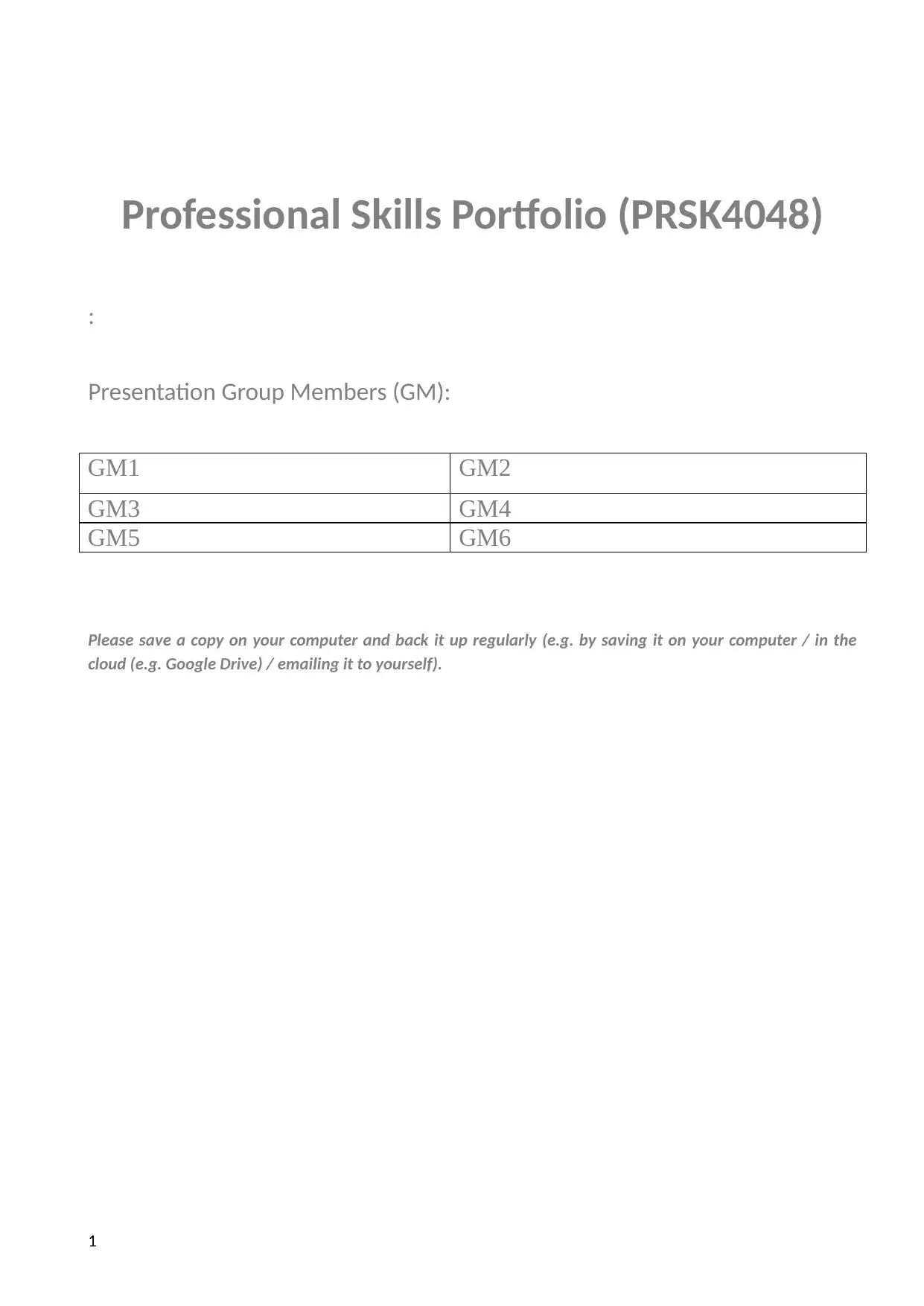
Professional Skills Portfolio (PRSK4048)
:
Presentation Group Members (GM):
GM1 GM2
GM3 GM4
GM5 GM6
Please save a copy on your computer and back it up regularly (e.g. by saving it on your computer / in the
cloud (e.g. Google Drive) / emailing it to yourself).
1
:
Presentation Group Members (GM):
GM1 GM2
GM3 GM4
GM5 GM6
Please save a copy on your computer and back it up regularly (e.g. by saving it on your computer / in the
cloud (e.g. Google Drive) / emailing it to yourself).
1
Paraphrase This Document
Need a fresh take? Get an instant paraphrase of this document with our AI Paraphraser
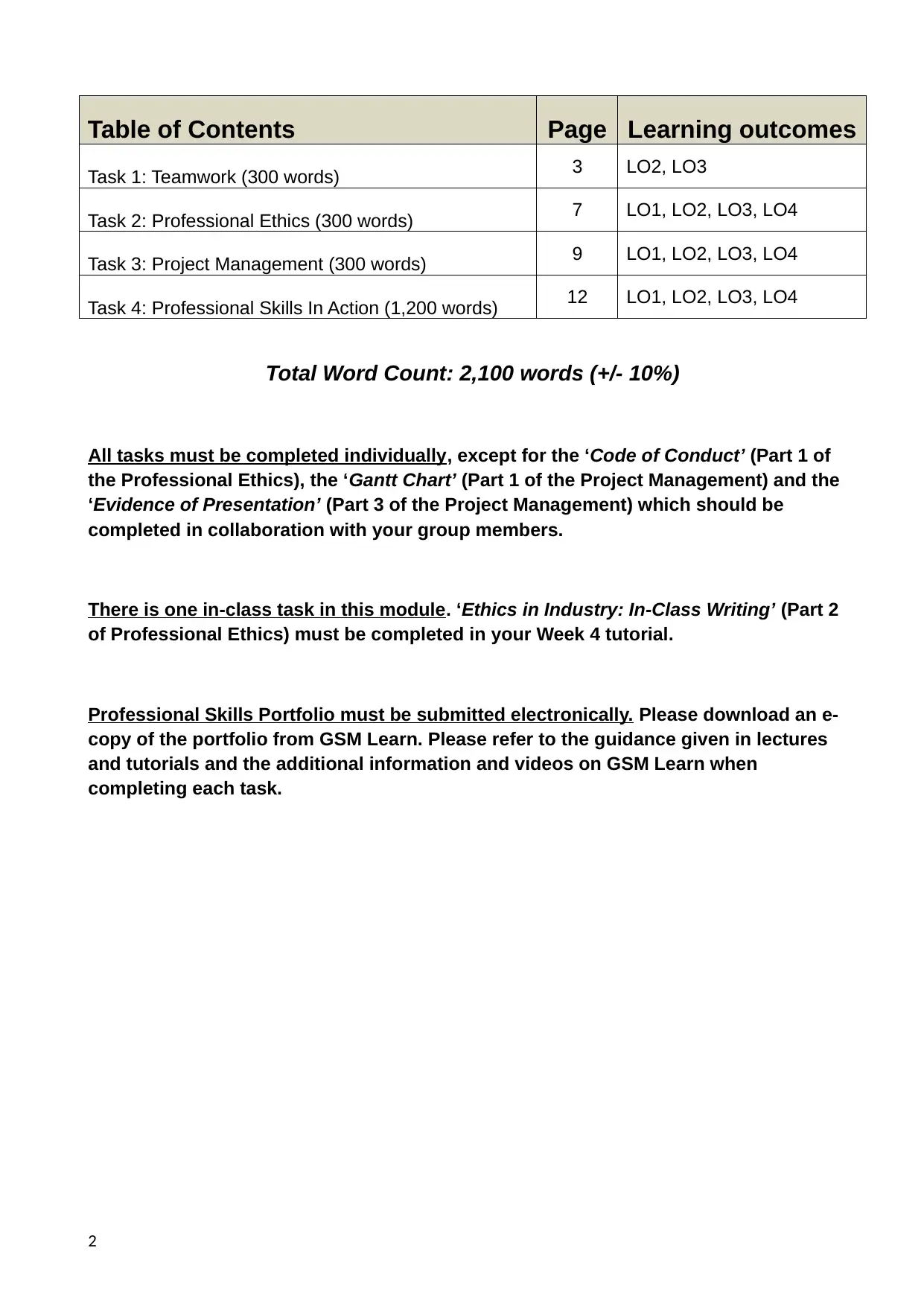
Table of Contents Page Learning outcomes
Task 1: Teamwork (300 words) 3 LO2, LO3
Task 2: Professional Ethics (300 words) 7 LO1, LO2, LO3, LO4
Task 3: Project Management (300 words) 9 LO1, LO2, LO3, LO4
Task 4: Professional Skills In Action (1,200 words) 12 LO1, LO2, LO3, LO4
Total Word Count: 2,100 words (+/- 10%)
All tasks must be completed individually, except for the ‘Code of Conduct’ (Part 1 of
the Professional Ethics), the ‘Gantt Chart’ (Part 1 of the Project Management) and the
‘Evidence of Presentation’ (Part 3 of the Project Management) which should be
completed in collaboration with your group members.
There is one in-class task in this module. ‘Ethics in Industry: In-Class Writing’ (Part 2
of Professional Ethics) must be completed in your Week 4 tutorial.
Professional Skills Portfolio must be submitted electronically. Please download an e-
copy of the portfolio from GSM Learn. Please refer to the guidance given in lectures
and tutorials and the additional information and videos on GSM Learn when
completing each task.
2
Task 1: Teamwork (300 words) 3 LO2, LO3
Task 2: Professional Ethics (300 words) 7 LO1, LO2, LO3, LO4
Task 3: Project Management (300 words) 9 LO1, LO2, LO3, LO4
Task 4: Professional Skills In Action (1,200 words) 12 LO1, LO2, LO3, LO4
Total Word Count: 2,100 words (+/- 10%)
All tasks must be completed individually, except for the ‘Code of Conduct’ (Part 1 of
the Professional Ethics), the ‘Gantt Chart’ (Part 1 of the Project Management) and the
‘Evidence of Presentation’ (Part 3 of the Project Management) which should be
completed in collaboration with your group members.
There is one in-class task in this module. ‘Ethics in Industry: In-Class Writing’ (Part 2
of Professional Ethics) must be completed in your Week 4 tutorial.
Professional Skills Portfolio must be submitted electronically. Please download an e-
copy of the portfolio from GSM Learn. Please refer to the guidance given in lectures
and tutorials and the additional information and videos on GSM Learn when
completing each task.
2
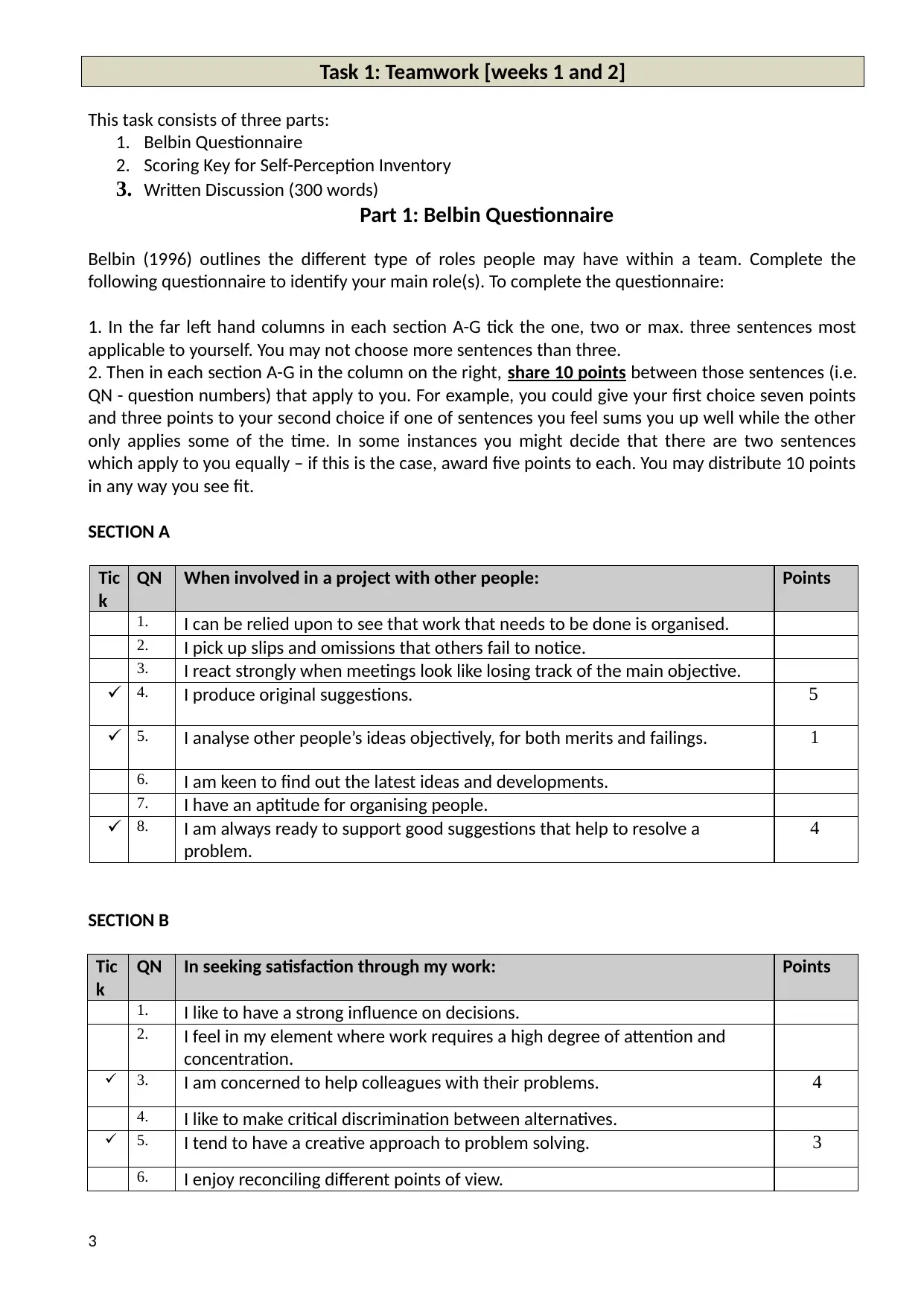
Task 1: Teamwork [weeks 1 and 2]
This task consists of three parts:
1. Belbin Questionnaire
2. Scoring Key for Self-Perception Inventory
3. Written Discussion (300 words)
Part 1: Belbin Questionnaire
Belbin (1996) outlines the different type of roles people may have within a team. Complete the
following questionnaire to identify your main role(s). To complete the questionnaire:
1. In the far left hand columns in each section A-G tick the one, two or max. three sentences most
applicable to yourself. You may not choose more sentences than three.
2. Then in each section A-G in the column on the right, share 10 points between those sentences (i.e.
QN - question numbers) that apply to you. For example, you could give your first choice seven points
and three points to your second choice if one of sentences you feel sums you up well while the other
only applies some of the time. In some instances you might decide that there are two sentences
which apply to you equally – if this is the case, award five points to each. You may distribute 10 points
in any way you see fit.
SECTION A
Tic
k
QN When involved in a project with other people: Points
1. I can be relied upon to see that work that needs to be done is organised.
2. I pick up slips and omissions that others fail to notice.
3. I react strongly when meetings look like losing track of the main objective.
4. I produce original suggestions. 5
5. I analyse other people’s ideas objectively, for both merits and failings. 1
6. I am keen to find out the latest ideas and developments.
7. I have an aptitude for organising people.
8. I am always ready to support good suggestions that help to resolve a
problem.
4
SECTION B
Tic
k
QN In seeking satisfaction through my work: Points
1. I like to have a strong influence on decisions.
2. I feel in my element where work requires a high degree of attention and
concentration.
3. I am concerned to help colleagues with their problems. 4
4. I like to make critical discrimination between alternatives.
5. I tend to have a creative approach to problem solving. 3
6. I enjoy reconciling different points of view.
3
This task consists of three parts:
1. Belbin Questionnaire
2. Scoring Key for Self-Perception Inventory
3. Written Discussion (300 words)
Part 1: Belbin Questionnaire
Belbin (1996) outlines the different type of roles people may have within a team. Complete the
following questionnaire to identify your main role(s). To complete the questionnaire:
1. In the far left hand columns in each section A-G tick the one, two or max. three sentences most
applicable to yourself. You may not choose more sentences than three.
2. Then in each section A-G in the column on the right, share 10 points between those sentences (i.e.
QN - question numbers) that apply to you. For example, you could give your first choice seven points
and three points to your second choice if one of sentences you feel sums you up well while the other
only applies some of the time. In some instances you might decide that there are two sentences
which apply to you equally – if this is the case, award five points to each. You may distribute 10 points
in any way you see fit.
SECTION A
Tic
k
QN When involved in a project with other people: Points
1. I can be relied upon to see that work that needs to be done is organised.
2. I pick up slips and omissions that others fail to notice.
3. I react strongly when meetings look like losing track of the main objective.
4. I produce original suggestions. 5
5. I analyse other people’s ideas objectively, for both merits and failings. 1
6. I am keen to find out the latest ideas and developments.
7. I have an aptitude for organising people.
8. I am always ready to support good suggestions that help to resolve a
problem.
4
SECTION B
Tic
k
QN In seeking satisfaction through my work: Points
1. I like to have a strong influence on decisions.
2. I feel in my element where work requires a high degree of attention and
concentration.
3. I am concerned to help colleagues with their problems. 4
4. I like to make critical discrimination between alternatives.
5. I tend to have a creative approach to problem solving. 3
6. I enjoy reconciling different points of view.
3
⊘ This is a preview!⊘
Do you want full access?
Subscribe today to unlock all pages.

Trusted by 1+ million students worldwide
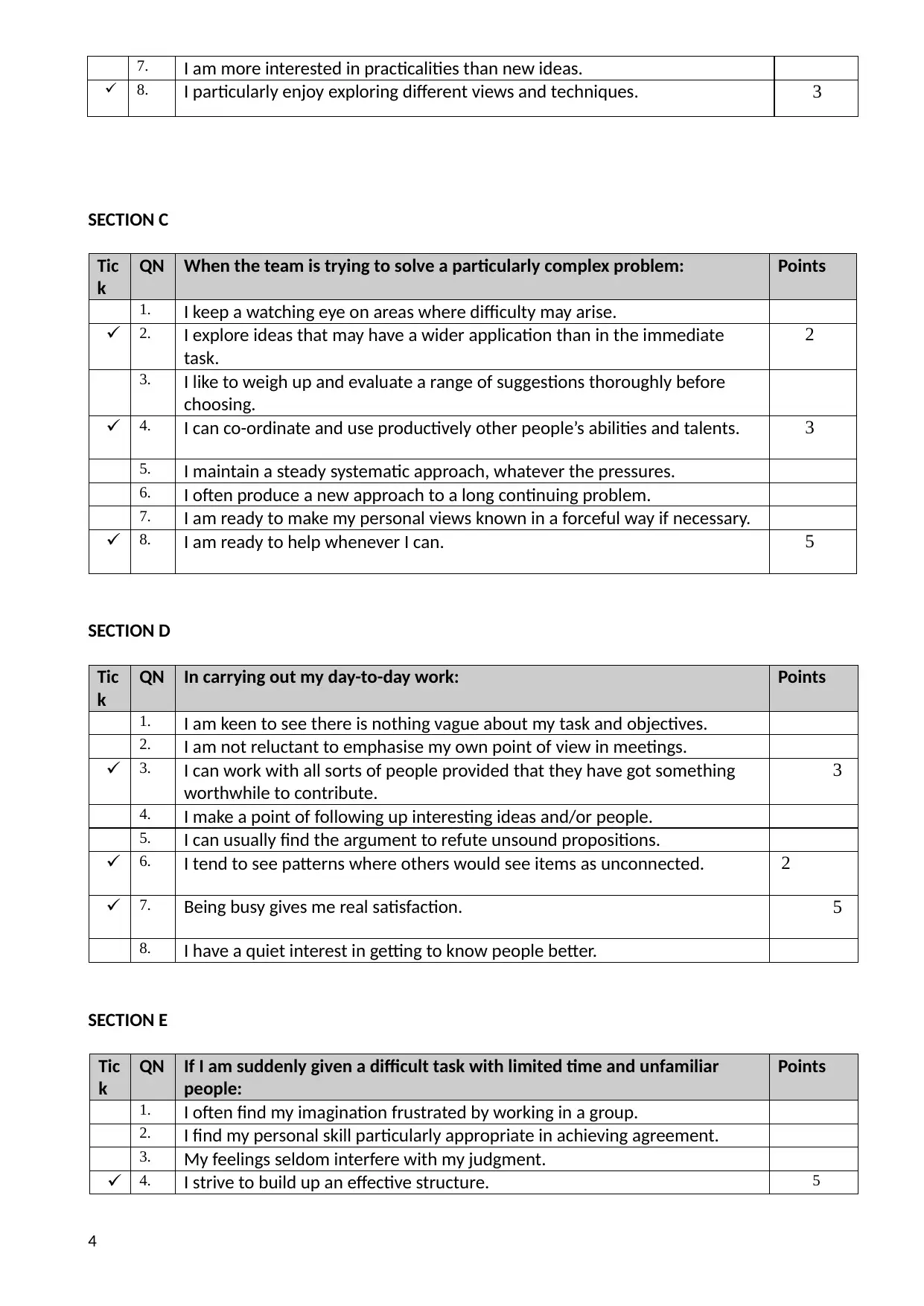
7. I am more interested in practicalities than new ideas.
8. I particularly enjoy exploring different views and techniques. 3
SECTION C
Tic
k
QN When the team is trying to solve a particularly complex problem: Points
1. I keep a watching eye on areas where difficulty may arise.
2. I explore ideas that may have a wider application than in the immediate
task.
2
3. I like to weigh up and evaluate a range of suggestions thoroughly before
choosing.
4. I can co-ordinate and use productively other people’s abilities and talents. 3
5. I maintain a steady systematic approach, whatever the pressures.
6. I often produce a new approach to a long continuing problem.
7. I am ready to make my personal views known in a forceful way if necessary.
8. I am ready to help whenever I can. 5
SECTION D
Tic
k
QN In carrying out my day-to-day work: Points
1. I am keen to see there is nothing vague about my task and objectives.
2. I am not reluctant to emphasise my own point of view in meetings.
3. I can work with all sorts of people provided that they have got something
worthwhile to contribute.
3
4. I make a point of following up interesting ideas and/or people.
5. I can usually find the argument to refute unsound propositions.
6. I tend to see patterns where others would see items as unconnected. 2
7. Being busy gives me real satisfaction. 5
8. I have a quiet interest in getting to know people better.
SECTION E
Tic
k
QN If I am suddenly given a difficult task with limited time and unfamiliar
people:
Points
1. I often find my imagination frustrated by working in a group.
2. I find my personal skill particularly appropriate in achieving agreement.
3. My feelings seldom interfere with my judgment.
4. I strive to build up an effective structure. 5
4
8. I particularly enjoy exploring different views and techniques. 3
SECTION C
Tic
k
QN When the team is trying to solve a particularly complex problem: Points
1. I keep a watching eye on areas where difficulty may arise.
2. I explore ideas that may have a wider application than in the immediate
task.
2
3. I like to weigh up and evaluate a range of suggestions thoroughly before
choosing.
4. I can co-ordinate and use productively other people’s abilities and talents. 3
5. I maintain a steady systematic approach, whatever the pressures.
6. I often produce a new approach to a long continuing problem.
7. I am ready to make my personal views known in a forceful way if necessary.
8. I am ready to help whenever I can. 5
SECTION D
Tic
k
QN In carrying out my day-to-day work: Points
1. I am keen to see there is nothing vague about my task and objectives.
2. I am not reluctant to emphasise my own point of view in meetings.
3. I can work with all sorts of people provided that they have got something
worthwhile to contribute.
3
4. I make a point of following up interesting ideas and/or people.
5. I can usually find the argument to refute unsound propositions.
6. I tend to see patterns where others would see items as unconnected. 2
7. Being busy gives me real satisfaction. 5
8. I have a quiet interest in getting to know people better.
SECTION E
Tic
k
QN If I am suddenly given a difficult task with limited time and unfamiliar
people:
Points
1. I often find my imagination frustrated by working in a group.
2. I find my personal skill particularly appropriate in achieving agreement.
3. My feelings seldom interfere with my judgment.
4. I strive to build up an effective structure. 5
4
Paraphrase This Document
Need a fresh take? Get an instant paraphrase of this document with our AI Paraphraser
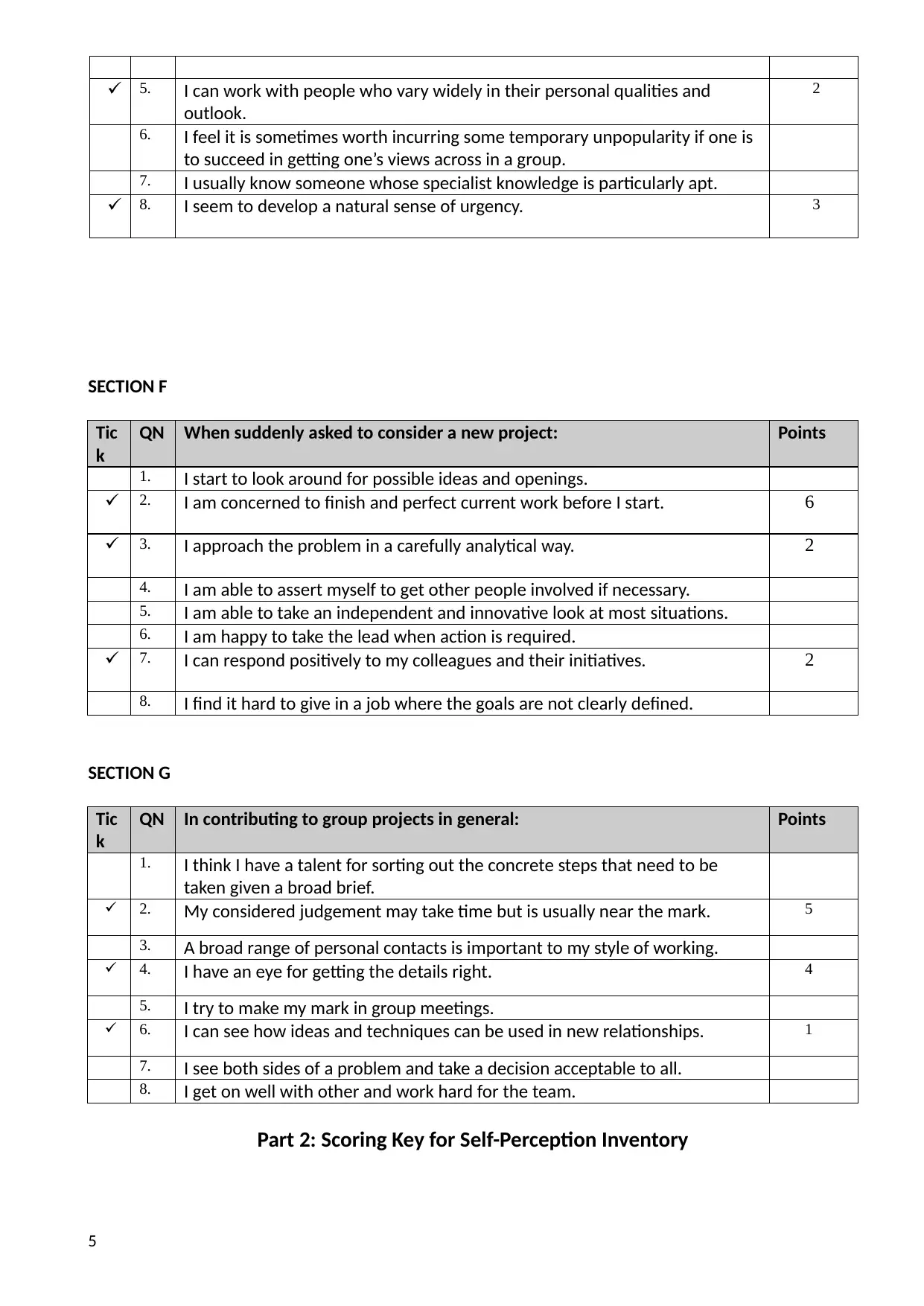
5. I can work with people who vary widely in their personal qualities and
outlook.
2
6. I feel it is sometimes worth incurring some temporary unpopularity if one is
to succeed in getting one’s views across in a group.
7. I usually know someone whose specialist knowledge is particularly apt.
8. I seem to develop a natural sense of urgency. 3
SECTION F
Tic
k
QN When suddenly asked to consider a new project: Points
1. I start to look around for possible ideas and openings.
2. I am concerned to finish and perfect current work before I start. 6
3. I approach the problem in a carefully analytical way. 2
4. I am able to assert myself to get other people involved if necessary.
5. I am able to take an independent and innovative look at most situations.
6. I am happy to take the lead when action is required.
7. I can respond positively to my colleagues and their initiatives. 2
8. I find it hard to give in a job where the goals are not clearly defined.
SECTION G
Tic
k
QN In contributing to group projects in general: Points
1. I think I have a talent for sorting out the concrete steps that need to be
taken given a broad brief.
2. My considered judgement may take time but is usually near the mark. 5
3. A broad range of personal contacts is important to my style of working.
4. I have an eye for getting the details right. 4
5. I try to make my mark in group meetings.
6. I can see how ideas and techniques can be used in new relationships. 1
7. I see both sides of a problem and take a decision acceptable to all.
8. I get on well with other and work hard for the team.
Part 2: Scoring Key for Self-Perception Inventory
5
outlook.
2
6. I feel it is sometimes worth incurring some temporary unpopularity if one is
to succeed in getting one’s views across in a group.
7. I usually know someone whose specialist knowledge is particularly apt.
8. I seem to develop a natural sense of urgency. 3
SECTION F
Tic
k
QN When suddenly asked to consider a new project: Points
1. I start to look around for possible ideas and openings.
2. I am concerned to finish and perfect current work before I start. 6
3. I approach the problem in a carefully analytical way. 2
4. I am able to assert myself to get other people involved if necessary.
5. I am able to take an independent and innovative look at most situations.
6. I am happy to take the lead when action is required.
7. I can respond positively to my colleagues and their initiatives. 2
8. I find it hard to give in a job where the goals are not clearly defined.
SECTION G
Tic
k
QN In contributing to group projects in general: Points
1. I think I have a talent for sorting out the concrete steps that need to be
taken given a broad brief.
2. My considered judgement may take time but is usually near the mark. 5
3. A broad range of personal contacts is important to my style of working.
4. I have an eye for getting the details right. 4
5. I try to make my mark in group meetings.
6. I can see how ideas and techniques can be used in new relationships. 1
7. I see both sides of a problem and take a decision acceptable to all.
8. I get on well with other and work hard for the team.
Part 2: Scoring Key for Self-Perception Inventory
5
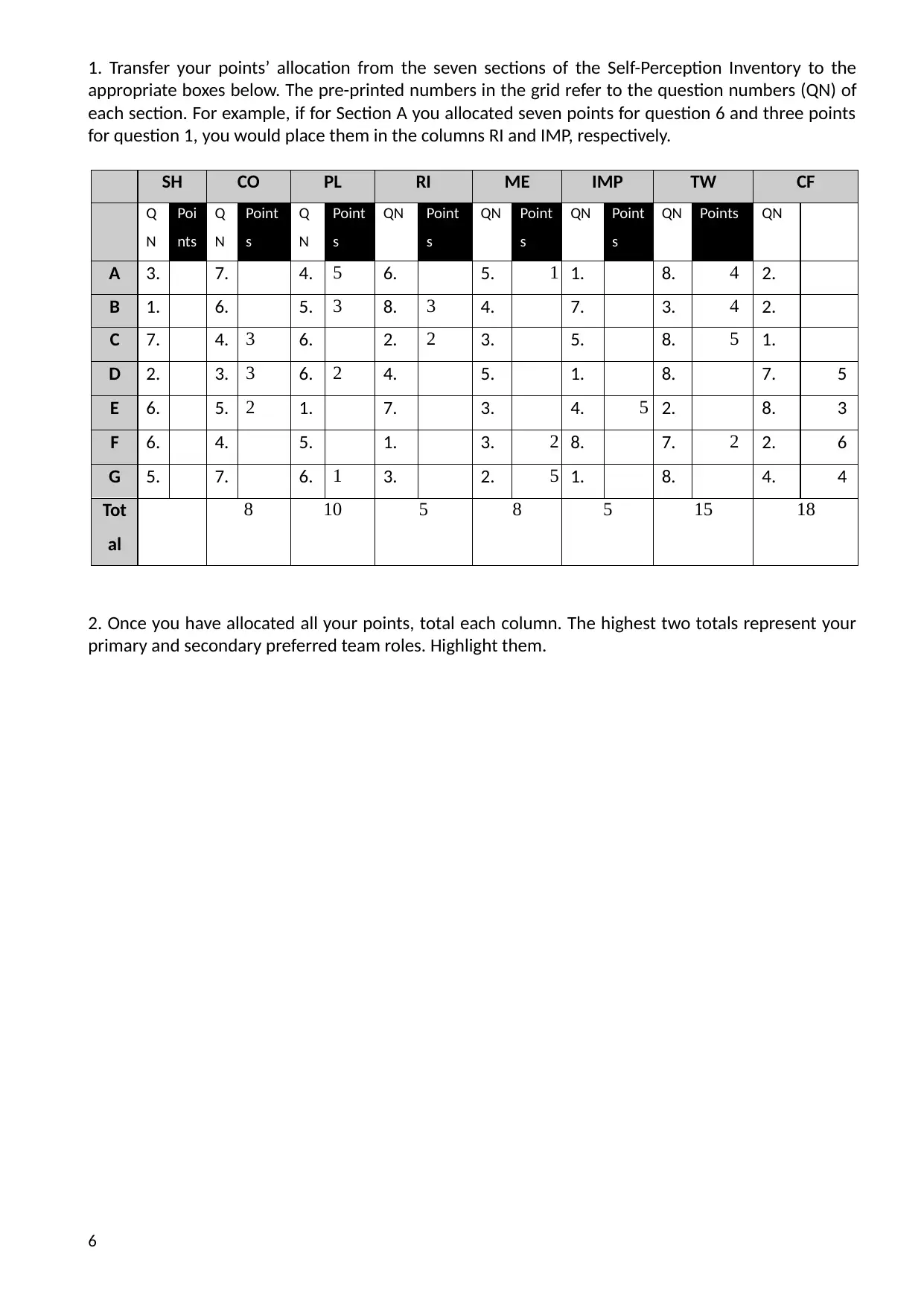
1. Transfer your points’ allocation from the seven sections of the Self-Perception Inventory to the
appropriate boxes below. The pre-printed numbers in the grid refer to the question numbers (QN) of
each section. For example, if for Section A you allocated seven points for question 6 and three points
for question 1, you would place them in the columns RI and IMP, respectively.
SH CO PL RI ME IMP TW CF
Q
N
Poi
nts
Q
N
Point
s
Q
N
Point
s
QN Point
s
QN Point
s
QN Point
s
QN Points QN
A 3. 7. 4. 5 6. 5. 1 1. 8. 4 2.
B 1. 6. 5. 3 8. 3 4. 7. 3. 4 2.
C 7. 4. 3 6. 2. 2 3. 5. 8. 5 1.
D 2. 3. 3 6. 2 4. 5. 1. 8. 7. 5
E 6. 5. 2 1. 7. 3. 4. 5 2. 8. 3
F 6. 4. 5. 1. 3. 2 8. 7. 2 2. 6
G 5. 7. 6. 1 3. 2. 5 1. 8. 4. 4
Tot
al
8 10 5 8 5 15 18
2. Once you have allocated all your points, total each column. The highest two totals represent your
primary and secondary preferred team roles. Highlight them.
6
appropriate boxes below. The pre-printed numbers in the grid refer to the question numbers (QN) of
each section. For example, if for Section A you allocated seven points for question 6 and three points
for question 1, you would place them in the columns RI and IMP, respectively.
SH CO PL RI ME IMP TW CF
Q
N
Poi
nts
Q
N
Point
s
Q
N
Point
s
QN Point
s
QN Point
s
QN Point
s
QN Points QN
A 3. 7. 4. 5 6. 5. 1 1. 8. 4 2.
B 1. 6. 5. 3 8. 3 4. 7. 3. 4 2.
C 7. 4. 3 6. 2. 2 3. 5. 8. 5 1.
D 2. 3. 3 6. 2 4. 5. 1. 8. 7. 5
E 6. 5. 2 1. 7. 3. 4. 5 2. 8. 3
F 6. 4. 5. 1. 3. 2 8. 7. 2 2. 6
G 5. 7. 6. 1 3. 2. 5 1. 8. 4. 4
Tot
al
8 10 5 8 5 15 18
2. Once you have allocated all your points, total each column. The highest two totals represent your
primary and secondary preferred team roles. Highlight them.
6
⊘ This is a preview!⊘
Do you want full access?
Subscribe today to unlock all pages.

Trusted by 1+ million students worldwide
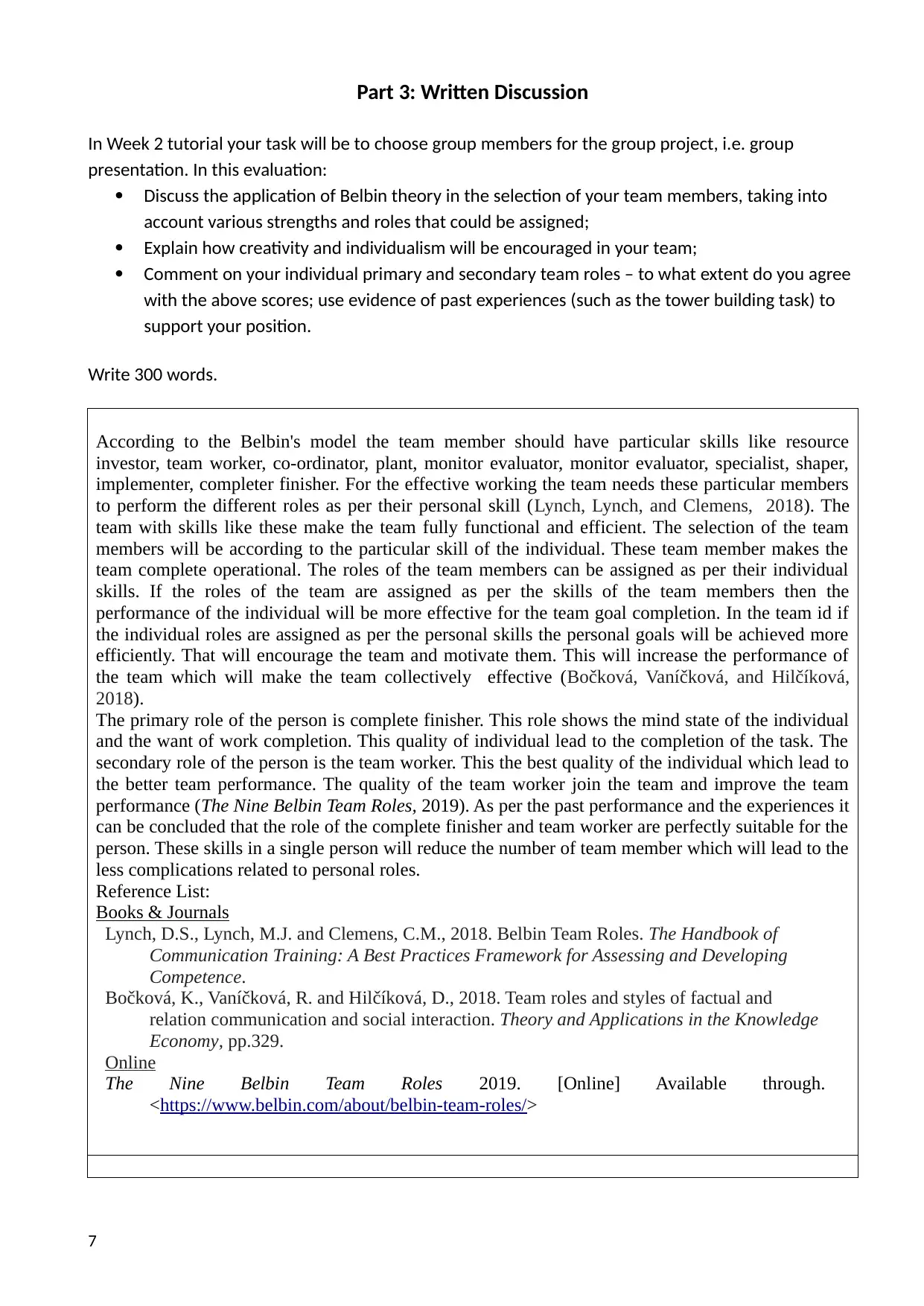
Part 3: Written Discussion
In Week 2 tutorial your task will be to choose group members for the group project, i.e. group
presentation. In this evaluation:
Discuss the application of Belbin theory in the selection of your team members, taking into
account various strengths and roles that could be assigned;
Explain how creativity and individualism will be encouraged in your team;
Comment on your individual primary and secondary team roles – to what extent do you agree
with the above scores; use evidence of past experiences (such as the tower building task) to
support your position.
Write 300 words.
According to the Belbin's model the team member should have particular skills like resource
investor, team worker, co-ordinator, plant, monitor evaluator, monitor evaluator, specialist, shaper,
implementer, completer finisher. For the effective working the team needs these particular members
to perform the different roles as per their personal skill (Lynch, Lynch, and Clemens, 2018). The
team with skills like these make the team fully functional and efficient. The selection of the team
members will be according to the particular skill of the individual. These team member makes the
team complete operational. The roles of the team members can be assigned as per their individual
skills. If the roles of the team are assigned as per the skills of the team members then the
performance of the individual will be more effective for the team goal completion. In the team id if
the individual roles are assigned as per the personal skills the personal goals will be achieved more
efficiently. That will encourage the team and motivate them. This will increase the performance of
the team which will make the team collectively effective (Bočková, Vaníčková, and Hilčíková,
2018).
The primary role of the person is complete finisher. This role shows the mind state of the individual
and the want of work completion. This quality of individual lead to the completion of the task. The
secondary role of the person is the team worker. This the best quality of the individual which lead to
the better team performance. The quality of the team worker join the team and improve the team
performance (The Nine Belbin Team Roles, 2019). As per the past performance and the experiences it
can be concluded that the role of the complete finisher and team worker are perfectly suitable for the
person. These skills in a single person will reduce the number of team member which will lead to the
less complications related to personal roles.
Reference List:
Books & Journals
Lynch, D.S., Lynch, M.J. and Clemens, C.M., 2018. Belbin Team Roles. The Handbook of
Communication Training: A Best Practices Framework for Assessing and Developing
Competence.
Bočková, K., Vaníčková, R. and Hilčíková, D., 2018. Team roles and styles of factual and
relation communication and social interaction. Theory and Applications in the Knowledge
Economy, pp.329.
Online
The Nine Belbin Team Roles 2019. [Online] Available through.
<https://www.belbin.com/about/belbin-team-roles/>
7
In Week 2 tutorial your task will be to choose group members for the group project, i.e. group
presentation. In this evaluation:
Discuss the application of Belbin theory in the selection of your team members, taking into
account various strengths and roles that could be assigned;
Explain how creativity and individualism will be encouraged in your team;
Comment on your individual primary and secondary team roles – to what extent do you agree
with the above scores; use evidence of past experiences (such as the tower building task) to
support your position.
Write 300 words.
According to the Belbin's model the team member should have particular skills like resource
investor, team worker, co-ordinator, plant, monitor evaluator, monitor evaluator, specialist, shaper,
implementer, completer finisher. For the effective working the team needs these particular members
to perform the different roles as per their personal skill (Lynch, Lynch, and Clemens, 2018). The
team with skills like these make the team fully functional and efficient. The selection of the team
members will be according to the particular skill of the individual. These team member makes the
team complete operational. The roles of the team members can be assigned as per their individual
skills. If the roles of the team are assigned as per the skills of the team members then the
performance of the individual will be more effective for the team goal completion. In the team id if
the individual roles are assigned as per the personal skills the personal goals will be achieved more
efficiently. That will encourage the team and motivate them. This will increase the performance of
the team which will make the team collectively effective (Bočková, Vaníčková, and Hilčíková,
2018).
The primary role of the person is complete finisher. This role shows the mind state of the individual
and the want of work completion. This quality of individual lead to the completion of the task. The
secondary role of the person is the team worker. This the best quality of the individual which lead to
the better team performance. The quality of the team worker join the team and improve the team
performance (The Nine Belbin Team Roles, 2019). As per the past performance and the experiences it
can be concluded that the role of the complete finisher and team worker are perfectly suitable for the
person. These skills in a single person will reduce the number of team member which will lead to the
less complications related to personal roles.
Reference List:
Books & Journals
Lynch, D.S., Lynch, M.J. and Clemens, C.M., 2018. Belbin Team Roles. The Handbook of
Communication Training: A Best Practices Framework for Assessing and Developing
Competence.
Bočková, K., Vaníčková, R. and Hilčíková, D., 2018. Team roles and styles of factual and
relation communication and social interaction. Theory and Applications in the Knowledge
Economy, pp.329.
Online
The Nine Belbin Team Roles 2019. [Online] Available through.
<https://www.belbin.com/about/belbin-team-roles/>
7
Paraphrase This Document
Need a fresh take? Get an instant paraphrase of this document with our AI Paraphraser
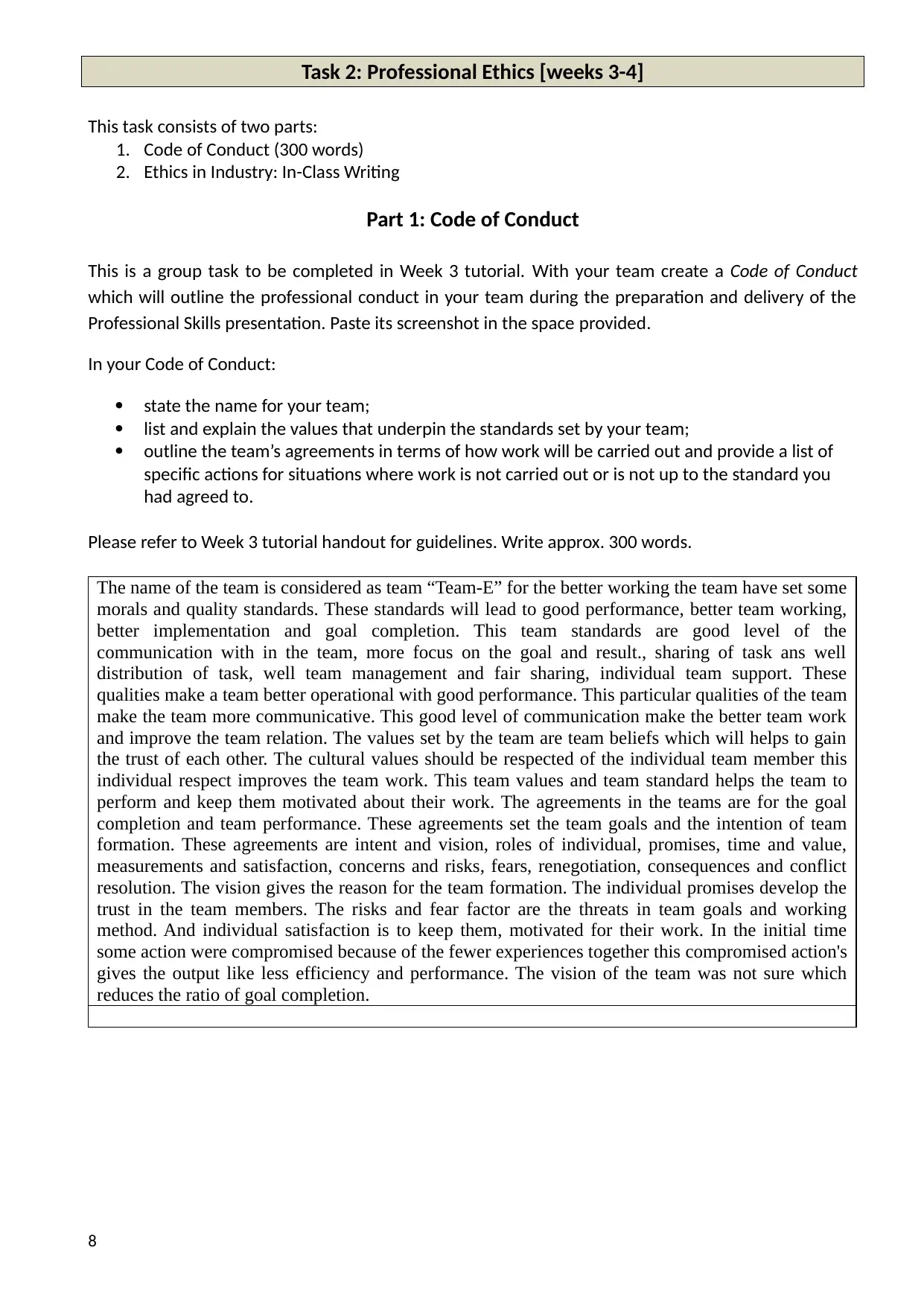
Task 2: Professional Ethics [weeks 3-4]
This task consists of two parts:
1. Code of Conduct (300 words)
2. Ethics in Industry: In-Class Writing
Part 1: Code of Conduct
This is a group task to be completed in Week 3 tutorial. With your team create a Code of Conduct
which will outline the professional conduct in your team during the preparation and delivery of the
Professional Skills presentation. Paste its screenshot in the space provided.
In your Code of Conduct:
state the name for your team;
list and explain the values that underpin the standards set by your team;
outline the team’s agreements in terms of how work will be carried out and provide a list of
specific actions for situations where work is not carried out or is not up to the standard you
had agreed to.
Please refer to Week 3 tutorial handout for guidelines. Write approx. 300 words.
The name of the team is considered as team “Team-E” for the better working the team have set some
morals and quality standards. These standards will lead to good performance, better team working,
better implementation and goal completion. This team standards are good level of the
communication with in the team, more focus on the goal and result., sharing of task ans well
distribution of task, well team management and fair sharing, individual team support. These
qualities make a team better operational with good performance. This particular qualities of the team
make the team more communicative. This good level of communication make the better team work
and improve the team relation. The values set by the team are team beliefs which will helps to gain
the trust of each other. The cultural values should be respected of the individual team member this
individual respect improves the team work. This team values and team standard helps the team to
perform and keep them motivated about their work. The agreements in the teams are for the goal
completion and team performance. These agreements set the team goals and the intention of team
formation. These agreements are intent and vision, roles of individual, promises, time and value,
measurements and satisfaction, concerns and risks, fears, renegotiation, consequences and conflict
resolution. The vision gives the reason for the team formation. The individual promises develop the
trust in the team members. The risks and fear factor are the threats in team goals and working
method. And individual satisfaction is to keep them, motivated for their work. In the initial time
some action were compromised because of the fewer experiences together this compromised action's
gives the output like less efficiency and performance. The vision of the team was not sure which
reduces the ratio of goal completion.
8
This task consists of two parts:
1. Code of Conduct (300 words)
2. Ethics in Industry: In-Class Writing
Part 1: Code of Conduct
This is a group task to be completed in Week 3 tutorial. With your team create a Code of Conduct
which will outline the professional conduct in your team during the preparation and delivery of the
Professional Skills presentation. Paste its screenshot in the space provided.
In your Code of Conduct:
state the name for your team;
list and explain the values that underpin the standards set by your team;
outline the team’s agreements in terms of how work will be carried out and provide a list of
specific actions for situations where work is not carried out or is not up to the standard you
had agreed to.
Please refer to Week 3 tutorial handout for guidelines. Write approx. 300 words.
The name of the team is considered as team “Team-E” for the better working the team have set some
morals and quality standards. These standards will lead to good performance, better team working,
better implementation and goal completion. This team standards are good level of the
communication with in the team, more focus on the goal and result., sharing of task ans well
distribution of task, well team management and fair sharing, individual team support. These
qualities make a team better operational with good performance. This particular qualities of the team
make the team more communicative. This good level of communication make the better team work
and improve the team relation. The values set by the team are team beliefs which will helps to gain
the trust of each other. The cultural values should be respected of the individual team member this
individual respect improves the team work. This team values and team standard helps the team to
perform and keep them motivated about their work. The agreements in the teams are for the goal
completion and team performance. These agreements set the team goals and the intention of team
formation. These agreements are intent and vision, roles of individual, promises, time and value,
measurements and satisfaction, concerns and risks, fears, renegotiation, consequences and conflict
resolution. The vision gives the reason for the team formation. The individual promises develop the
trust in the team members. The risks and fear factor are the threats in team goals and working
method. And individual satisfaction is to keep them, motivated for their work. In the initial time
some action were compromised because of the fewer experiences together this compromised action's
gives the output like less efficiency and performance. The vision of the team was not sure which
reduces the ratio of goal completion.
8
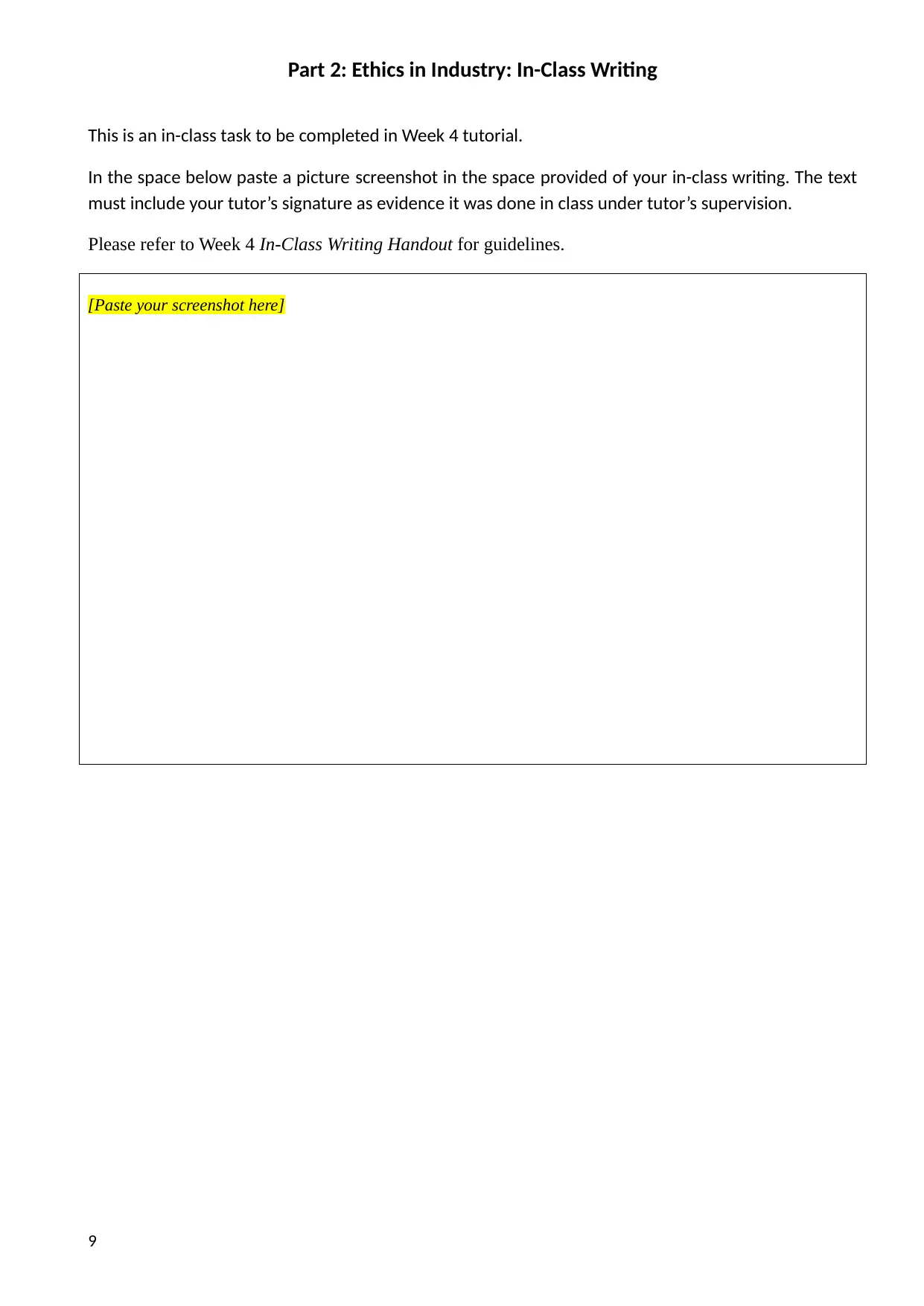
Part 2: Ethics in Industry: In-Class Writing
This is an in-class task to be completed in Week 4 tutorial.
In the space below paste a picture screenshot in the space provided of your in-class writing. The text
must include your tutor’s signature as evidence it was done in class under tutor’s supervision.
Please refer to Week 4 In-Class Writing Handout for guidelines.
[Paste your screenshot here]
9
This is an in-class task to be completed in Week 4 tutorial.
In the space below paste a picture screenshot in the space provided of your in-class writing. The text
must include your tutor’s signature as evidence it was done in class under tutor’s supervision.
Please refer to Week 4 In-Class Writing Handout for guidelines.
[Paste your screenshot here]
9
⊘ This is a preview!⊘
Do you want full access?
Subscribe today to unlock all pages.

Trusted by 1+ million students worldwide
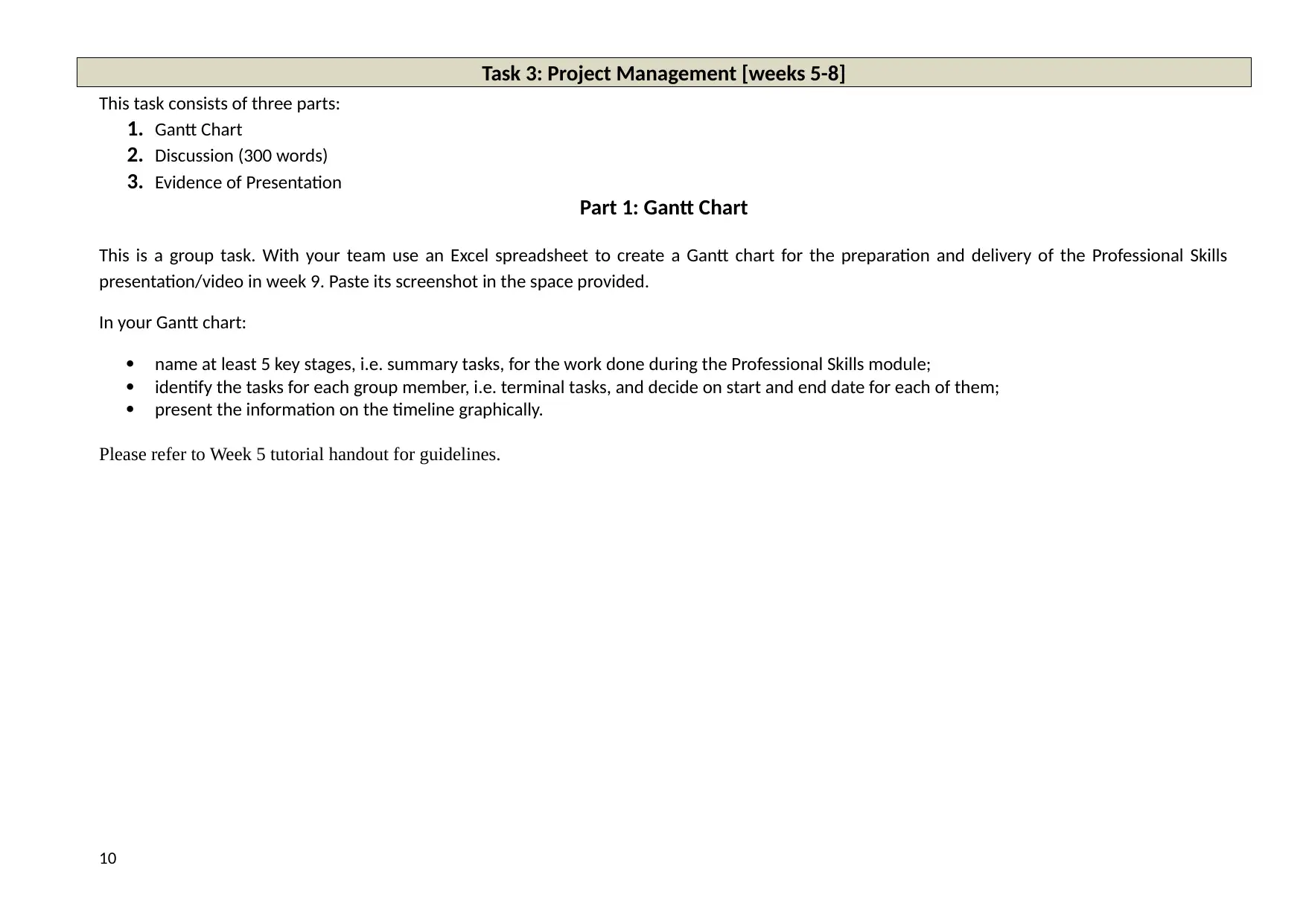
Task 3: Project Management [weeks 5-8]
This task consists of three parts:
1. Gantt Chart
2. Discussion (300 words)
3. Evidence of Presentation
Part 1: Gantt Chart
This is a group task. With your team use an Excel spreadsheet to create a Gantt chart for the preparation and delivery of the Professional Skills
presentation/video in week 9. Paste its screenshot in the space provided.
In your Gantt chart:
name at least 5 key stages, i.e. summary tasks, for the work done during the Professional Skills module;
identify the tasks for each group member, i.e. terminal tasks, and decide on start and end date for each of them;
present the information on the timeline graphically.
Please refer to Week 5 tutorial handout for guidelines.
10
This task consists of three parts:
1. Gantt Chart
2. Discussion (300 words)
3. Evidence of Presentation
Part 1: Gantt Chart
This is a group task. With your team use an Excel spreadsheet to create a Gantt chart for the preparation and delivery of the Professional Skills
presentation/video in week 9. Paste its screenshot in the space provided.
In your Gantt chart:
name at least 5 key stages, i.e. summary tasks, for the work done during the Professional Skills module;
identify the tasks for each group member, i.e. terminal tasks, and decide on start and end date for each of them;
present the information on the timeline graphically.
Please refer to Week 5 tutorial handout for guidelines.
10
Paraphrase This Document
Need a fresh take? Get an instant paraphrase of this document with our AI Paraphraser
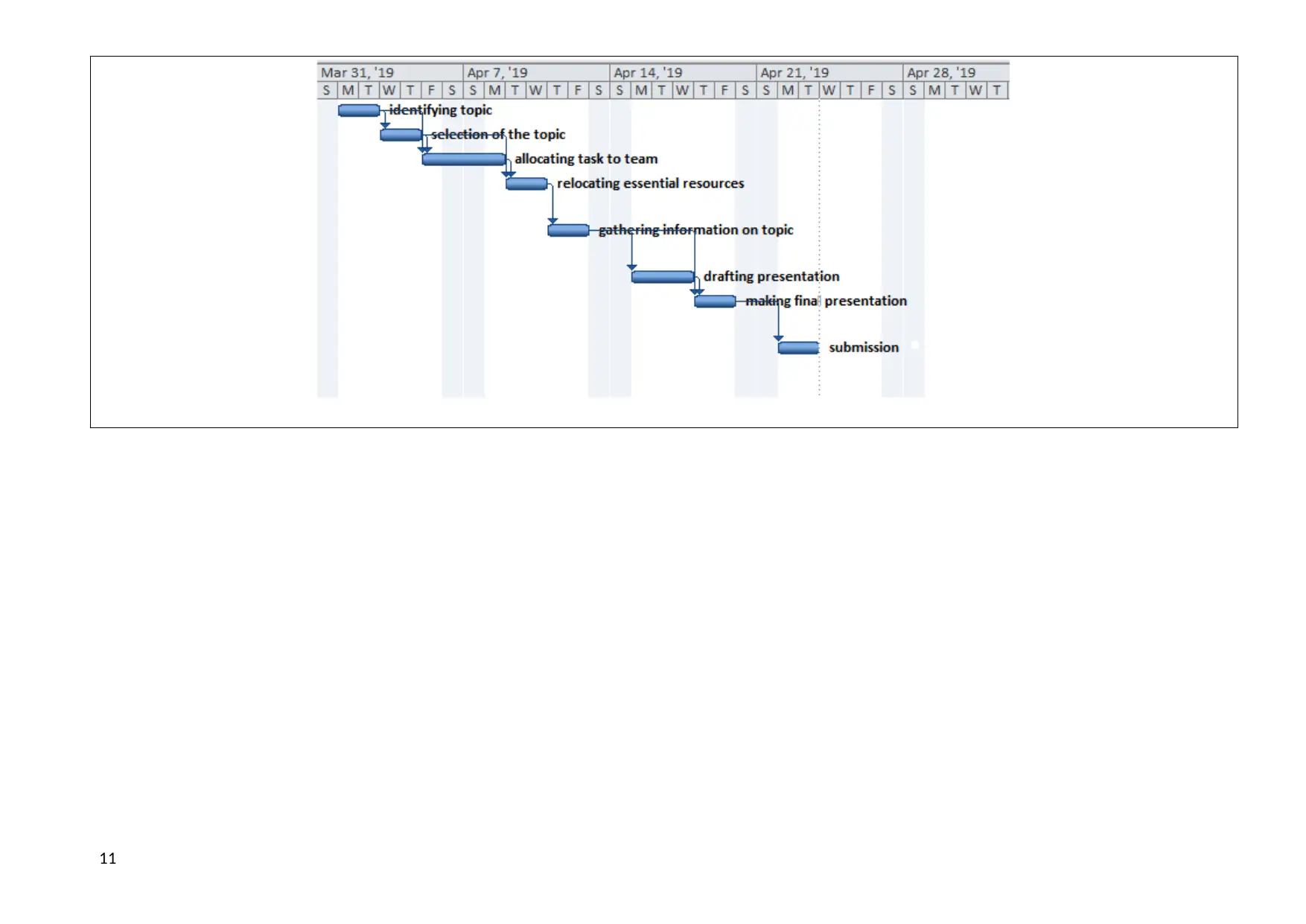
11
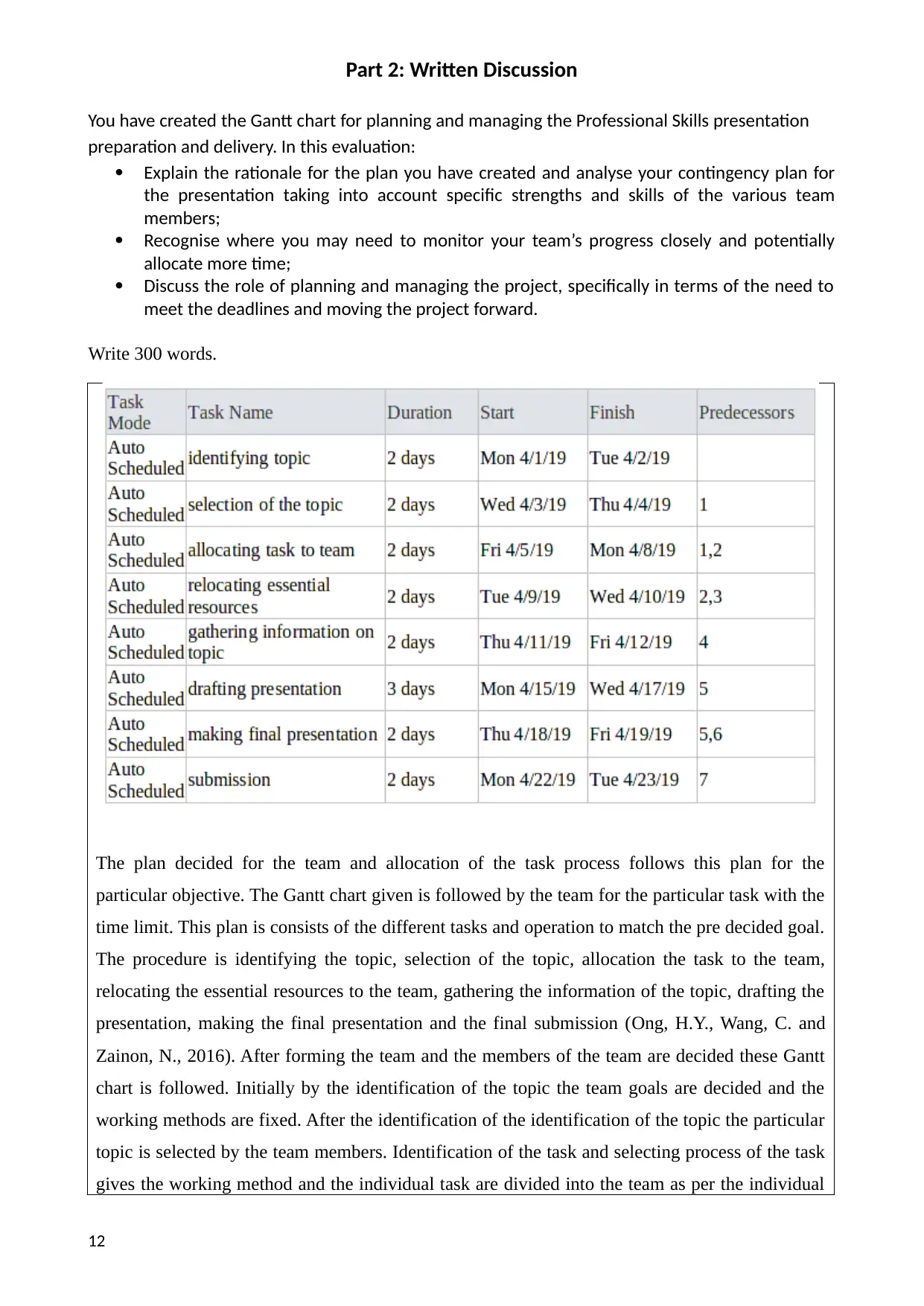
Part 2: Written Discussion
You have created the Gantt chart for planning and managing the Professional Skills presentation
preparation and delivery. In this evaluation:
Explain the rationale for the plan you have created and analyse your contingency plan for
the presentation taking into account specific strengths and skills of the various team
members;
Recognise where you may need to monitor your team’s progress closely and potentially
allocate more time;
Discuss the role of planning and managing the project, specifically in terms of the need to
meet the deadlines and moving the project forward.
Write 300 words.
The plan decided for the team and allocation of the task process follows this plan for the
particular objective. The Gantt chart given is followed by the team for the particular task with the
time limit. This plan is consists of the different tasks and operation to match the pre decided goal.
The procedure is identifying the topic, selection of the topic, allocation the task to the team,
relocating the essential resources to the team, gathering the information of the topic, drafting the
presentation, making the final presentation and the final submission (Ong, H.Y., Wang, C. and
Zainon, N., 2016). After forming the team and the members of the team are decided these Gantt
chart is followed. Initially by the identification of the topic the team goals are decided and the
working methods are fixed. After the identification of the identification of the topic the particular
topic is selected by the team members. Identification of the task and selecting process of the task
gives the working method and the individual task are divided into the team as per the individual
12
You have created the Gantt chart for planning and managing the Professional Skills presentation
preparation and delivery. In this evaluation:
Explain the rationale for the plan you have created and analyse your contingency plan for
the presentation taking into account specific strengths and skills of the various team
members;
Recognise where you may need to monitor your team’s progress closely and potentially
allocate more time;
Discuss the role of planning and managing the project, specifically in terms of the need to
meet the deadlines and moving the project forward.
Write 300 words.
The plan decided for the team and allocation of the task process follows this plan for the
particular objective. The Gantt chart given is followed by the team for the particular task with the
time limit. This plan is consists of the different tasks and operation to match the pre decided goal.
The procedure is identifying the topic, selection of the topic, allocation the task to the team,
relocating the essential resources to the team, gathering the information of the topic, drafting the
presentation, making the final presentation and the final submission (Ong, H.Y., Wang, C. and
Zainon, N., 2016). After forming the team and the members of the team are decided these Gantt
chart is followed. Initially by the identification of the topic the team goals are decided and the
working methods are fixed. After the identification of the identification of the topic the particular
topic is selected by the team members. Identification of the task and selecting process of the task
gives the working method and the individual task are divided into the team as per the individual
12
⊘ This is a preview!⊘
Do you want full access?
Subscribe today to unlock all pages.

Trusted by 1+ million students worldwide
1 out of 19
Related Documents
Your All-in-One AI-Powered Toolkit for Academic Success.
+13062052269
info@desklib.com
Available 24*7 on WhatsApp / Email
![[object Object]](/_next/static/media/star-bottom.7253800d.svg)
Unlock your academic potential
Copyright © 2020–2025 A2Z Services. All Rights Reserved. Developed and managed by ZUCOL.





